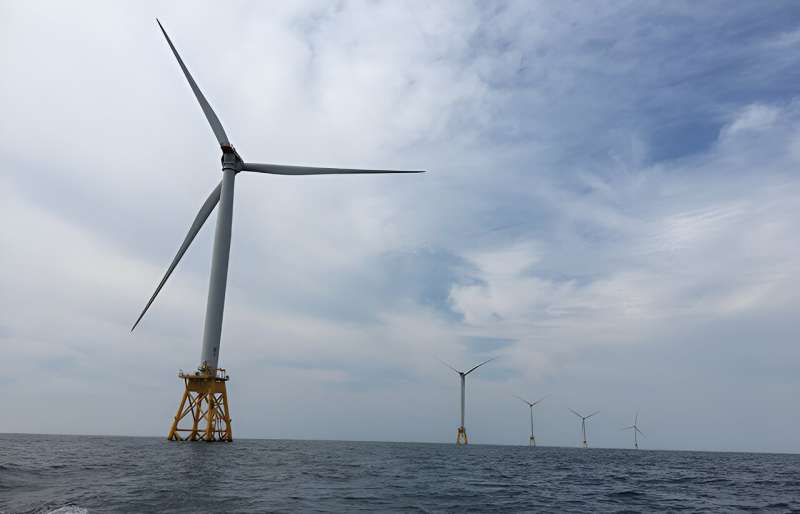This article has been reviewed according to Science X's editorial process and policies. Editors have highlighted the following attributes while ensuring the content's credibility:
fact-checked
peer-reviewed publication
trusted source
proofread
Analysis identifies drivers of offshore wind development

As much as 20% of regional power needs along the Atlantic coast could be served by offshore wind farms by 2050, according to researchers with the U.S. Department of Energy's National Renewable Energy Laboratory (NREL) who modeled deployment of this emerging U.S. energy sector in new depth and detail.
The researchers who performed the analysis considered a diversity of scenarios to more clearly understand how a single renewable resource can affect the country's target of decarbonizing the power system. The current role of offshore wind electricity in the United States has been understudied, they said.
The researchers found offshore wind could generate as much as 8% of the nation's electricity by 2050, but that deployment could range widely, from 30 to 250 gigawatts, depending on how a variety of factors related to the power system evolve over the coming decades.
The analysis, "Expanded modeling scenarios to understand the role of offshore wind in decarbonizing the United States," appears in the journal Nature Energy.
NREL co-authors Philipp Beiter, Trieu Mai, and Matt Mowers collaborated with John Bistline from the independent, nonprofit energy R&D institute EPRI to explore a wide range of scenarios related to policy, technology costs, transmission, and siting.
The authors deploy a capacity expansion model and find that high levels of offshore wind deployment are most likely in scenarios where there is a combination of stringent decarbonization policies, low technology costs, fewer siting options for onshore renewables, and limited interregional transmission. For example, the study's core scenario considers strict zoning regulations for onshore wind and solar panels that expand offshore wind's market potential.
"We represent siting, energy supply, and transmission at a high spatial and temporal resolution," said lead author Beiter, "which allows us to explore a range of decarbonization pathways and offshore wind's future role."
By taking into account various conditions, the researchers are able to more fully consider the growing number and severity of trade-offs that arise with decarbonization scenarios. The results of the analysis illustrate how limitations affect deployment and could lead to different conclusions.
In many of the scenarios studied, offshore wind deployment is limited to the level defined by current state commitments, with solar photovoltaics and onshore wind meeting most new electricity demand through 2050. The amount of energy from nuclear, hydropower, and fossil fuels is relatively constant across the scenarios, with fossil generation limited by an emissions cap, unless carbon capture and sequestration technology is available and economically viable.
Under the study's core scenario with high load growth and electrification, offshore wind accounts for 133 gigawatts by 2050. By comparison, the installed land-based wind farms scattered across the United States today total about 141 gigawatts and produce 10% of the country's electricity.
"For newer generation sources like offshore wind, it is particularly important to identify the types of conditions when they may be viable in different parts of the country," Mai said.
In the United States, only two small offshore wind plants off the coasts of Rhode Island and Virginia are currently in operation, but many more are proposed along the Atlantic and Pacific coasts. The first U.S. large-scale offshore wind farm—with a planned installed capacity of 800 megawatts—could start generating power as early as this autumn off the coast of Massachusetts.
The high uncertainty about future decarbonization pathways also raises the need for greater coordination between local, state, and federal authorities in power sector and offshore wind infrastructure planning, the researchers noted.
"Our study highlights several limitations that—if not addressed—can yield starkly different futures for U.S. offshore wind," Beiter said. "That said, many inherent limitations of energy system modeling remain and require careful interpretation and presentation."
More information: Philipp Beiter et al, Expanded modelling scenarios to understand the role of offshore wind in decarbonizing the United States, Nature Energy (2023). DOI: 10.1038/s41560-023-01364-y


















